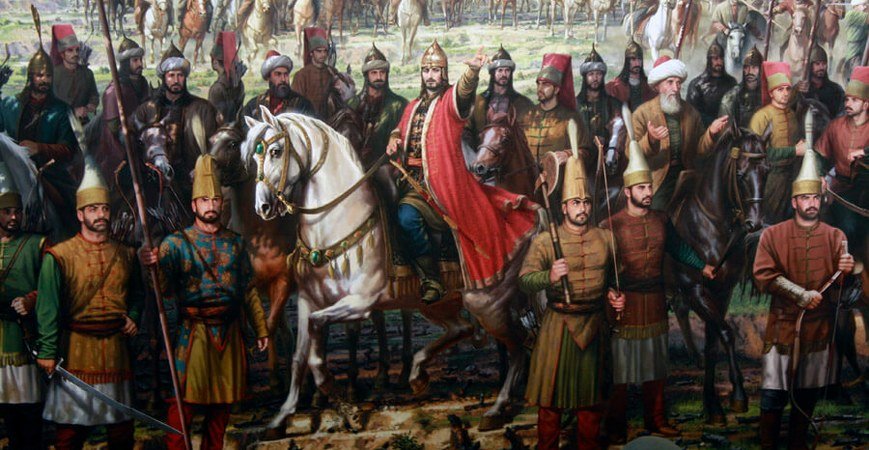The Fatih Sultan Mehmed’s Caftan in Istanbul Topkapi Palace,
In the spring of 1481 Sultan Mehmed, the Conqueror was making preparations for a new campaign. The campaign symbol, the sultan’s tenants, had been set on Uskudar. Although the destination was not made public, it was obvious that it was somewhere in Asia from the fact that the army had gathered on the Anatolian side of the Bosphorus. On April 27 the Conqueror crossed to Uskudar. His face was pale and his actions languid. It was known that he had suffered from pain in his joints for a considerable time. He rested in Uskudar for several days, then got in a carriage and gave the order to his soldiers to set off. When the convoy arrived near Gebze at the Tekfur meadows, his condition considerably worsened. The doctors drew some blood and pronounced that it was inadvisable for the sultan to continue on his journey. The sultan’s tent was set up, and the Conqueror retired to it. His temperature rose, and medicines and sherbets did nothing to improve his condition. On Thursday, May 5, towards noon, this great statesman took his last breath. It was essential to hide his death from the soldiers. His body was dressed and placed in a closed carriage. It was announced that the Sultan would spend a few days bathing in Istanbul before the journey was continued. Even in spite of this secrecy, however, the news of his death leaked out and a section of the janissaries returned to Istanbul. However, without any great confusion or feeding the prince Beyazid who at that time was governor of Amasya managed to get to Istanbul within 9 days and take over his father’s throne. At the time of his death, the Conqueror was wearing an indigo blue caftan made of Bursa silk. This caftan was cut from his body and today is exhibited in the section containing clothing of the sultans in Topkapi Palace Museum. Of significance as the last piece of clothing worn by the Sultan, it was filled with fine cotton and lined with a fine beige colored cloth. There are twelve buttons down the front of the caftan. Apart from this caftan, there are also underclothing, other captains, iron armor, the helmet and the emerald aigrette of the Conqueror. Among his caftans is one made of gold worked brocade, of which both the style and cloth itself are beautiful. The caftan is decorated with intertwined insignias of Sultan Suleyman, tulips, carnations and roses among four large clouds. Another caftan of the sultan is made of silk brocade from Bursa upon which is worked a star pattern containing tulips and pomegranate flowers, surrounded by a design of clouds. The sleeves of the caftan are short, the front is worked with silver thread and it is double breasted. From measurements taken from these caftans the measurements of the Conqueror have been worked out, showing him to have been 1.70 m. in height, slim and well proportioned. During the time of the Conqueror, Turkish textiles were much advanced. Particularly the Bursa silk of this period had no equal. The velvet brocades, gold and silver thread worked brocades, cloth of gold called ‘seraser’ and ‘zerbaft’, fine silks and satins were sent to the four corners of the state, and the richest clothing made from them. Apart from Bursa, the checked cloth of Denizli, the alpaca of Ankara, the fine cotton of Manisa and the woolen cloth made in Diyarbakir were also famous. In the palace was a special tailor’s shop where the clothes for the sultan were made. The tailors would be told the sultan’s measurements and sew clothes for him. The Chief Agha was in charge of the sultan’s clothes, and the Tulbend Agha in charge of the sultan’s underclothes and turbans. Sultan Mehmed the Conqueror used to wind his turban in the style of scholars like his grandfather Chelebi Sultan Mehmed. Usually, he wore furs with collars over his caftans. During the days of the conquest of Istanbul, the Conqueror did not remove his caftan for 53 days because night and day he was at the head of the army. Today in Topkapi Palace you can see all sizes of clothes belonging to every sultan from Osman Gazi to the last Ottoman sultan. Each one, besides being a historical souvenir of the Sultans is also the finest examples of Turkish textiles of each period. But all eyes are drawn to the caftans of the Conqueror. His gold worked caftans were in keeping with the greatness of the Ottoman Sultan Mehmed II, Conqueror of Istanbul.

Leave a Reply